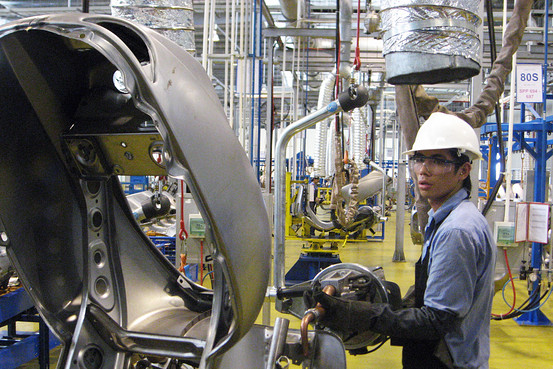Vietnam auto industry could splutter and die
Vietnam’s regional and global tax-cut commitments could mean the death of local car makers within the next ten years if there are be no improvements to the industry’s development strategy, a trade official said.
That scenario would also include an ballooning trade deficit caused by the flood of imported cars, said Ngo Van Tru, deputy director of the Heavy Industry Department at the Ministry of Industry and Trade.

Under the country’s free trade deal with the regional grouping ASEAN, car import taxes will drop to between 0 and 5 percent by 2018 from the current 83 percent. Meanwhile, the World Trade Organization commitments will make taxes on cars from the regional bloc’s members go down to 70 percent in 2014 and 47 percent in 2017.
The lower taxes would bring competitive advantages to imports in term of prices, Tru said. Even now, locally-made cars are much more expensive than their equivalents produced in other economies, he noted.
Tru estimated that the country would import US$20 billion worth of cars from ASEAN markets by 2020. The amount is equivalent to Vietnam’s forex reserves at the end of 2008.
Vietnam imported nearly 57,000 cars worth $903 million in the first ten months of this year, according to the government’s statistics agency. During the same period, local assemblers sold more than 92,000 cars, the Vietnam Auto Manufacturers’ Association (VAMA) said.
The car industry would therefore play a decisive role in addressing Vietnam’s trade balance, Tru said.
He suggested car makers gather strength by focusing on developing a number of “strategic” car lines while the government improve roads and ease taxes aimed at buyers.
Fledgling, after decades
The automobile industry in Vietnam was formed in the early 1990s with the government licensing foreign investors and protecting them with high import taxes. The car makers committed to increase locally made parts in cars to 60 percent by 2010.
However, the industry and its supporting sectors still remain at the infant stage. Toyoto Innova, the model that has the highest proportion of local components in the country at 37 percent, compares poorly to the 80-90 percent for pick up trucks in neighboring Thailand, which also maintains a high localization rate of 30 to 70 percent for its passenger cars.
With local content in homemade cars very low, prices have stayed high compared to other countries and economies.
Even so, the demand for cars has been high and increasing steadily, with buyers sometimes having to register and wait for several months before they can get one.
Yet the car makers have blamed their low production volumes, and consequent high prices, on the government’s apparent intention to limit car use so as not to overload the underdeveloped road system.
The government has levied a luxury tax as high as 60 percent on cars. Meanwhile, it has also been constrained by a lack of funds for developing the infrastructure needed to accommodate the increasing number of vehicles hitting the streets every year.
Supporting industries would develop when production volumes were high, said Akito Tachibana, chief executive of Toyota Vietnam.
Tru said the development of transportation infrastructure and preferential tax policies had to go in tandem with efforts to boost the local car industry.
Meanwhile, Pham Dinh Thi, deputy general director of the finance ministry’s Tax Policy Department, said the tax policy should stay unchanged for now to protect the country from being flooded with cars and ensuing pollution.
The government should, however, have policies that promote development of component makers and help the domestic industry in the long run, he added.
